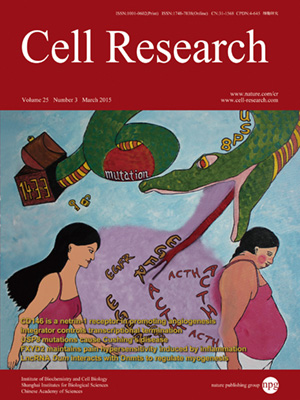
Volume 25, No 3, Mar 2015
ISSN: 1001-0602
EISSN: 1748-7838 2018
impact factor 17.848*
(Clarivate Analytics, 2019)
Volume 25 Issue 3, March 2015: 288-305 | Open Access
ORIGINAL ARTICLES
The Integrator complex controls the termination of transcription at diverse classes of gene targets
Jeffrey R Skaar1, Andrea L Ferris3, Xiaolin Wu4, Anita Saraf5, Kum Kum Khanna6, Laurence Florens5, Michael P Washburn5,7, Stephen H Hughes3 and Michele Pagano1,2
1Department of Pathology, Laura and Isaac Perlmutter Cancer Center, New York University School of Medicine, 522 First Avenue, New York, NY 10016, USA
2Howard Hughes Medical Institute, 522 First Avenue New York, NY 10016, USA
3HIV Drug Resistance Program, National Cancer Institute, Frederick, MD 21702, USA
4Cancer Research Technology Program, Leidos Biomedical Research, Inc., Frederick National Laboratory for Cancer Research, Frederick, MD 21702, USA
5The Stowers Institute for Medical Research, Kansas City, MO 6411, USA
6QIMR Berghofer Medical Research Institute, Herston, Brisbane, Queensland 4006, Australia
7Department of Pathology and Laboratory Medicine, The University of Kansas Medical Center, Kansas City, KS 66160, USA
Correspondence: Jeffrey R Skaar,(skaarlab@gmail.com)
Complexes containing INTS3 and either NABP1 or NABP2 were initially characterized in DNA damage responses, but their biochemical function remained unknown. Using affinity purifications and HIV Integration targeting-sequencing (HIT-Seq), we find that these complexes are part of the Integrator complex, which binds RNA Polymerase II and regulates specific target genes. Integrator cleaves snRNAs as part of their processing to their mature form in a mechanism that is intimately coupled with transcription termination. However, HIT-Seq reveals that Integrator also binds to the 3′ end of replication-dependent histones and promoter proximal regions of genes with polyadenylated transcripts. Depletion of Integrator subunits results in transcription termination failure, disruption of histone mRNA processing, and polyadenylation of snRNAs and histone mRNAs. Furthermore, promoter proximal binding of Integrator negatively regulates expression of genes whose transcripts are normally polyadenylated. Integrator recruitment to all three gene classes is DSIF-dependent, suggesting that Integrator functions as a termination complex at DSIF-dependent RNA Polymerase II pause sites.
10.1038/cr.2015.19
FULL TEXT | PDF
Browse 2339


